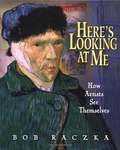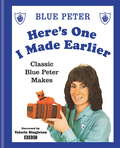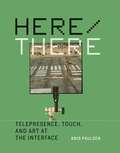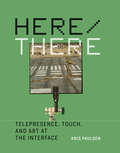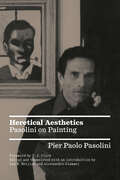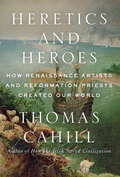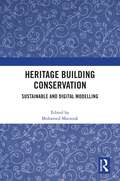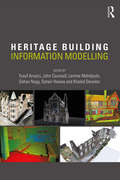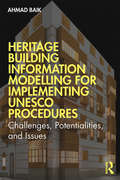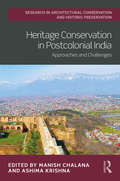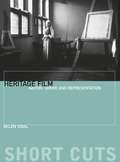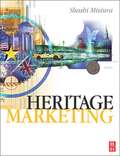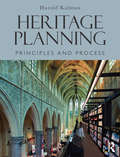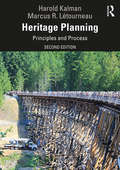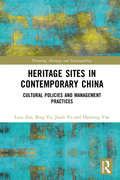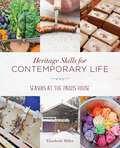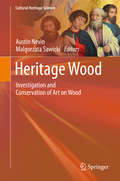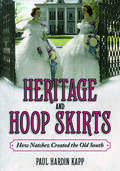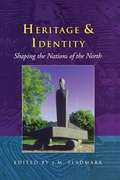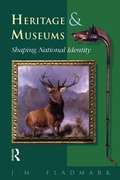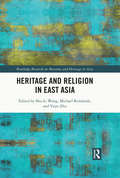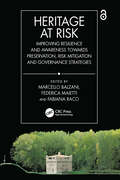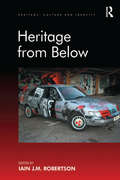- Table View
- List View
Here's Looking at Me: How Artists See Themselves
by Bob RaczkaThis book introduces self portraits of painters and photographers painted in a variety of styles.
Here's One I Made Earlier: Classic Blue Peter Makes
by BBC"Who would have thought you could create a cat bed from a washing-up bowl, design a doll's house from an old shoe box or make a flower pot from a margarine tub - all on live television!" Valerie Singleton, Blue Peter presenter 1962-1972"My ultimate favourite has to be Tracy Island. I loved all the little details, such as the bendable pipe cleaner, palm trees and that it was compatible with the shop bought Thunderbirds toys."Konnie Huq, Blue Peter presenter, 1997-2008Blue Peter is the longest-running children's programme in the world. At its peak, before the days of streaming andsocial media, it notched up 8 million viewers an episode and received a thousand letters a day. Recently voted the UK's best children's TV programme of all time, it was - and remains - famous for its makes, all of which used inexpensive household items such as cereal boxes and squeezy bottles, as well as the essential sticky-backed plastic and rubber solution glue. This affectionate celebration of the favourite makes from the show, has facsimiles from the Blue Peter annuals and includes the iconic Advent Crown, made with wire coat hangers, tinsel and candles. A Christmas Door Decoration, made from a polystyrene ceiling tile, some more tinsel and a cake doily. A Luxury Cat Basket, made from a washingup bowl. Plant Pots using old margarine tubs. A Doll's House made from a shoebox (with furniture made from matchboxes). Plus, of course, the instructions for the Blue Peter version of Thunderbirds Tracy Island.
Here/There: Telepresence, Touch, and Art at the Interface
by Kris Paulsen"Telepresence" allows us to feel present -- through vision, hearing, and even touch -- at a remote location by means of real-time communication technology. Networked devices such as video cameras and telerobots extend our corporeal agency into distant spaces. In Here/There, Kris Paulsen examines telepresence technologies through the lens of contemporary artistic experiments, from early video art through current "drone vision" works. Paulsen traces an arc of increasing interactivity, as video screens became spaces for communication and physical, tactile intervention. She explores the work of artists who took up these technological tools and questioned the aesthetic, social, and ethical stakes of media that allow us to manipulate and affect far-off environments and other people -- to touch, metaphorically and literally, those who cannot touch us back.Paulsen examines 1970s video artworks by Vito Acconci and Joan Jonas, live satellite performance projects by Kit Galloway and Sherrie Rabinowitz, and CCTV installations by Chris Burden. These early works, she argues, can help us make sense of the expansion of our senses by technologies that privilege real time over real space and model strategies for engagement and interaction with mediated others. They establish a political, aesthetic, and technological history for later works using cable TV infrastructures and the World Wide Web, including telerobotic works by Ken Goldberg and Wafaa Bilal and artworks about military drones by Trevor Paglen, Omar Fast, Hito Steyerl, and others. These works become a meeting place for here and there.
Here/There: Telepresence, Touch, and Art at the Interface (Leonardo)
by Kris PaulsenAn examination of telepresence technologies through the lens of contemporary artistic experiments, from early video art through current “drone vision” works."Telepresence” allows us to feel present—through vision, hearing, and even touch—at a remote location by means of real-time communication technology. Networked devices such as video cameras and telerobots extend our corporeal agency into distant spaces. In Here/There, Kris Paulsen examines telepresence technologies through the lens of contemporary artistic experiments, from early video art through current “drone vision” works. Paulsen traces an arc of increasing interactivity, as video screens became spaces for communication and physical, tactile intervention. She explores the work of artists who took up these technological tools and questioned the aesthetic, social, and ethical stakes of media that allow us to manipulate and affect far-off environments and other people—to touch, metaphorically and literally, those who cannot touch us back.Paulsen examines 1970s video artworks by Vito Acconci and Joan Jonas, live satellite performance projects by Kit Galloway and Sherrie Rabinowitz, and CCTV installations by Chris Burden. These early works, she argues, can help us make sense of the expansion of our senses by technologies that privilege real time over real space and model strategies for engagement and interaction with mediated others. They establish a political, aesthetic, and technological history for later works using cable TV infrastructures and the World Wide Web, including telerobotic works by Ken Goldberg and Wafaa Bilal and artworks about military drones by Trevor Paglen, Omar Fast, Hito Steyerl, and others. These works become a meeting place for here and there.
Heresy, Literature, and Politics in Early Modern English Culture
by David Loewenstein John MarshallThis interdisciplinary volume of essays brings together a team of leading early modern historians and literary scholars in order to examine the changing conceptions, character, and condemnation of 'heresy' in sixteenth- and seventeenth-century England. Definitions of 'heresy' and 'heretics' were the subject of heated controversies in England from the English Reformation to the end of the seventeenth century. These essays illuminate the significant literary issues involved in both defending and demonising heretical beliefs, including the contested hermeneutic strategies applied to the interpretation of the Bible, and they examine how debates over heresy stimulated the increasing articulation of arguments for religious toleration in England. Offering fresh perspectives on John Milton, Thomas Hobbes, John Locke and others, this volume should be of interest to all literary, religious and political historians working on early modern English culture.
Heretical Aesthetics: Pasolini on Painting
by T. J. ClarkFirst collection on filmmaker and poet Pasolini's passion for paintingOne of Europe's most mythologized Marxist intellectuals of the 20th century, Pier Paolo Pasolini was not only a poet, filmmaker, novelist, and political martyr. He was also a keen critic of painting. An intermittently practicing artist in his own right, Pasolini studied under the distinguished art historian Roberto Longhi, whose lessons marked a life-long affinity for figurative painting and its centrality to a particular cinematic sensibility.Pasolini set out wilfully to "contaminate" art criticism with semiotics, dialectology, and film theory, penning catalogue essays and exhibition reviews alongside poems, autobiographical meditations, and public lectures on painting. His fiercely idiosyncratic blend of Communism and classicism, localism and civic universalism, iconophilia and aesthetic "heresy," animated and antagonized Cold War culture like few European contemporaries. This book offers numerous texts previously available only in Italian, each accompanied by an editorial note elucidating its place in the tumultuous context of post-war Italian culture.Prefaced by the renowned art historian T.J. Clark, a historical essay on Pasolini's radical aesthetics anchors the anthology. One hundred years after his birth, Heretical Aesthetics sheds light on one of the most consequential aspects of Pasolini's intellectual life, further illuminating a vast cinematic and poetic corpus along the way.
Heretics and Heroes: How Renaissance Artists and Reformation Priests Created Our World (The Hinges of History)
by Thomas CahillThe New York Times bestselling author of How the Irish Saved Civilization reveals how the innovations of the Renaissance and the Reformation changed the Western world. • &“Cahill is our king of popular historians.&” —The Dallas Morning News This was an age in which whole continents and peoples were discovered. It was an era of sublime artistic and scientific adventure, but also of newly powerful princes and armies—and of unprecedented courage, as thousands refused to bow their heads to the religious pieties of the past. In these exquisitely written and lavishly illustrated pages, Cahill illuminates, as no one else can, the great gift-givers who shaped our history—those who left us a world more varied and complex, more awesome and delightful, more beautiful and strong than the one they had found.
Heritage Building Conservation: Sustainable and Digital Modelling
by Mohamed MarzoukThis book provides a holistic perspective on the sustainable conservation of heritage buildings through outlining the factors that influence the preservation, operational performance and maintainability of heritage buildings and the application of new methodologies and technologies. Using real cases from Egypt, a country which comprises a vast number of unique heritage structures, each of which is deteriorating at its own pace, this book presents a systematic, data-based approach to manage aging and deteriorating heritage assets in a cost-effective way. The authors initially provide an overview and history of conservation and maintenance work as well as the current codes and standards that regulate the preservation of these buildings. Further chapters then cover: The technology used to digitally document heritage buildings, including LIDAR, photogrammetry, Heritage Building Information Modelling (HBIM), and Virtual Reality (VR) technologies Introducing a Maintainability Index of Heritage Buildings (MIHB) to support the decision-making and prioritization process for the maintenance of heritage buildings The adaptive reuse of heritage buildings Modelling embodied and operational energy performance Using Chatbot and Blockchain technology to support the management and preservation of heritage buildings Ultimately, this book presents a useful tool for use in heritage management and highlights how the reusability of heritage buildings is critical to the creation and survival of sustainable communities. It will be useful reading for researchers, architects, engineers and especially those involved in the management of heritage buildings.
Heritage Building Information Modelling
by Yusuf Arayici John Counsell Lamine Mahdjoubi Gehan Ahmed Nagy Soheir Hawas Khaled DweidarBuilding Information Modelling (BIM) is being debated, tested and implemented wherever you look across the built environment sector. This book is about Heritage Building Information Modelling (HBIM), which necessarily differs from the commonplace applications of BIM to new construction. Where BIM is being used, the focus is still very much on design and construction. However, its use as an operational and management tool for existing buildings, particularly heritage buildings, is lagging behind. The first of its kind, this book aims to clearly define the scope for HBIM and present cutting-edge research findings alongside international case studies, before outlining challenges for the future of HBIM research and practice. After an extensive introduction to HBIM, the core themes of the book are arranged into four parts: Restoration philosophies in practice Data capture and visualisation for maintenance and repair Building performance Stakeholder engagement This book will be a key reference for built environment practitioners, researchers, academics and students engaged in BIM, HBIM, building energy modelling, building surveying, facilities management and heritage conservation more widely.
Heritage Building Information Modelling for Implementing UNESCO Procedures: Challenges, Potentialities, and Issues
by Ahmad Hamed BaikThe main aim of this book is to develop and explore the value of new innovative digital content to help satisfy UNESCO’s World Heritage nomination file requirements. Through a detailed exploration of two BIM case studies from Jeddah, Saudi Arabia, the book uniquely connects the use of Heritage BIM to the documentation methods used by UNESCO and demonstrates how this provides a contribution to both countries with heritage sites and UNESCO as an organisation. The research and practical examples in the book seek to address both the lack of a comprehensive method of submitting a nomination file to UNESCO and the lack of authentic engineering information in countries where extensive heritage sites exist. It looks at answering the following questions: How can Heritage Building Information Modelling (HBIM) be used to better maintain, protect, and record the updated information of historical buildings? How can HBIM provide innovation in creating the missing information for the assignment of UNESCO's World Heritage status? What additional value can a sustainable update of HBIM data provide for such sites? How can HBIM improve the cultural value of heritage buildings in the short, medium, and long term, as well as provide a better future for historical buildings? This book will be useful reading for researchers and practitioners in the areas of heritage conservation, archaeology, World Heritage nomination, HBIM, digital technology and engineering, remote sensing, laser scanning, and architectural technology.
Heritage Conservation in Postcolonial India: Approaches and Challenges (Routledge Research in Architectural Conservation and Historic Preservation)
by Manish Chalana and Ashima KrishnaHeritage Conservation in Postcolonial India seeks to position the conservation profession within historical, theoretical, and methodological frames to demonstrate how the field has evolved in the postcolonial decades and follow its various trajectories in research, education, advocacy, and practice. Split into four sections, this book covers important themes of institutional and programmatic developments in the field of conservation; critical and contemporary challenges facing the profession; emerging trends in practice that seek to address contemporary challenges; and sustainable solutions to conservation issues. The cases featured within the book elucidate the evolution of the heritage conservation profession, clarifying the role of key players at the central, state, and local level, and considering intangible, minority, colonial, modern, and vernacular heritages among others. This book also showcases unique strands of conservation practice in the postcolonial decades to demonstrate the range, scope, and multiple avenues of development in the last seven decades. An ideal read for those interested in architecture, planning, historic preservation, urban studies, and South Asian studies.
Heritage Film
by Belen VidalThis volume provides a comprehensive introduction to the critical debates around the heritage film, from its controversial status in British cinema of the 1980s to its expansion into a versatile international genre in the 1990s and 2000s. This study explores the heritage film in light of questions of national identity in film and television, industry and funding, and history, gender and representation. Using a wide range of examples and including an in-depth analysis of three case studies - Girl with a Pearl Earring (2003), Joyeux Noël (2005) and The Queen (2006) - this book presents the heritage film as a thriving phenomenon at the centre of contemporary European cinema.
Heritage Film: Nation, Genre, and Representation (Short Cuts)
by Belén VidalThis volume provides a comprehensive introduction to the critical debates around the heritage film, from its controversial status in British cinema of the 1980s to its expansion into a versatile international genre in the 1990s and 2000s. This study explores the heritage film in light of questions of national identity in film and television, industry and funding, and history, gender and representation. Using a wide range of examples and including an in-depth analysis of three case studies – Girl with a Pearl Earring (2003), Joyeux Noël (2005) and The Queen (2006) – this book presents the heritage film as a thriving phenomenon at the centre of contemporary European cinema.
Heritage Marketing
by Shashi MisiuraHeritage Marketing is a new and clearly written textbook that systematically addresses the principles of marketing as applied to the heritage sector. The 'heritage industry' and its growing importance internationally is defined, as is how it links with the study of modern tourism The book then goes on to look in detail at the marketing issues that arise from the particular management, educational and cultural aspects of heritage. The book is: * A clear introduction for students and professionals * Packed with examples and cases from around the world * The most up to date and comprehensive text of its kind As heritage tourism continues to grow, so the management and marketing of heritage resources will grow more important to governments, councils and managers. This book is the ideal way for all those new to the area to understand the fundamental principles and best practice in the sector.
Heritage Planning: Principles and Process
by Harold KalmanHeritage Planning: Principles and Process provides a comprehensive overview of heritage planning as an area of professional practice. The book first addresses the context and principles of heritage planning, including land-use law, planning practice, and international heritage doctrine, all set within the framework of larger societal issues such as sustainability and ethics. The book then takes readers through the pragmatic processes of heritage practice including collecting data, identifying community opinion, determining heritage significance, the best practices and methods of creating a conservation plan, and managing change. Heritage Planning recognizes changing approaches to heritage conservation, particularly the shift from the conservation of physical fabric to the present emphasis on retaining values, associations and stories that historic places hold for their communities. The transition has affected the practice of heritage planning and is important for those in the field. It is essential reading for both professionals that manage change within the built environment and students of heritage conservation and historic preservation.
Heritage Planning: Principles and Process
by Harold Kalman Marcus R. LétourneauThis new and substantially revised edition of Heritage Planning: Principles and Process offers an extensive overview of the burgeoning fields of heritage planning and conservation. Positioning professional practice within its broader applied and theoretical contexts, the authors provide a firm foundation for understanding the principles, history, evolution, debates, and tools that inform heritage planning, while also demonstrating how to effectively enact these processes. Few published works focus on the practice of heritage planning. The first edition of this book was developed to fill this gap, and this second edition builds upon it. The book has been expanded in scope to incorporate new research and approaches, as well as a wide range of international case studies. New themes reflect the emerging recognition that sustainability, climate resilience, human rights, social justice, and reconciliation are fundamental to the future of planning. Heritage Planning is indispensable reading, not only for professionals who transform the built environment, but for anyone who wants to understand the ideas and practices of heritage planning and conservation. For the benefit of student readers, twelve chapters—designed to accommodate the academic semester—are augmented with concise summaries, key terms and definitions, questions, and learning objectives.
Heritage Sites in Contemporary China: Cultural Policies and Management Practices (Planning, Heritage and Sustainability)
by Bing Yu Haiming Yan Luca Zan Jianli YuHeritage Sites in Contemporary China: Cultural Policies and Management Practices focuses on cultural heritage policies in China emerging in the period of the 11th and 12th Five Year Plans. Various important Chinese sites across China are investigated, including Luoyang Sui, Daming Gong, Niuheliang, Xinjiang, and Nanyuewang through the dual perspective of archaeological debate and as a case study of policy making. It explores the relationship between policy and the institutional and administrative conditions, such as budgeting and land concerns, which affect it. Building on the research project implemented by the China Academy for Cultural Heritage (CACH) from 2012–2014, which focused on the impact of the Dayizhi Policy for Great Archaeological Sites, the book provides an interdisciplinary insider’s approach to viewing archaeological discoveries; policies and emerging practices in site and archaeological management; and public administration in China. Featuring contributions from experts within CACH and from the Chinese community of archaeologists, and including numerous tables, data and maps, it will appeal to researchers and scholars in disciplines such as archaeology, heritage management, public administration, and policy making.
Heritage Skills for Contemporary Life: Seasons at the Parris House
by Elizabeth MillerNearly twenty years ago Beth Miller moved with her husband and four young kids from suburban New Jersey to a 200-year-old Federal period house and barn in rural Maine. She didn&’t garden, she didn&’t keep chickens or bees, she didn&’t know how to preserve food, and she didn&’t know how to make soap or hook rugs. She embarked on a journey to learn these heritage skills that have been largely forgotten, and today she owns and operates Parris House Wool Works, a traditional rug-hooking company serving both crafters and end buyers. It is also a working village homestead and workshop where she practices and teaches heritage skills, including all aspects of gardening, beekeeping, rug hooking, preserving, and soap making. Seasons at the Parris House is separated into seasonal sections and includes historical context and homestead related activities for each season, plus instructions for a set of related projects and recipes.
Heritage Wood: Investigation and Conservation of Art on Wood (Cultural Heritage Science)
by Austin Nevin Malgorzata SawickiThis volume highlights recent research efforts in the conservation and investigation of works of art on wood. Through eleven case studies it showcases different experimental methods ranging from X-ray analysis of objects to the study of cross-sections made from micro-samples. New research focusing on the technical study, treatment and assessment of works of art on wood in its many forms is featured in this edited volume. Technical studies include the attribution and investigations of a triptych by Hans Memling and a sculpture from workshop of Michel and Gregor Erhart, decorated Syrian rooms, and investigations of finely carved Gothic wooden objects. Synchrotron-based methods are presented for studying the alteration of 19th c. verdigris in Norway, and multi-analytical methods are employed for the investigations of 16th to 19th c. East Asian lacquer from the Kunsthistorisches Museum in Vienna. Novel methods for the cleaning of gilded surfaces using gels and emulsions are shown, as are innovative strategies for the consolidation for waterlogged wood, providing key data for the assessment of risks and benefits of new methods, and the short and long-term effects on gilding layers and archaeological wood. The book clearly shows how collaboration between engineers, physicists, biologists and chemists and conservators of different types of materials can lead to new research in conservation science. This book is crucial reading for conservators and conservation scientists, as well as for technical art historians, providing key methodological case studies of polychromy from different temporal and geographical contexts.
Heritage and Hoop Skirts: How Natchez Created the Old South
by Paul Hardin KappWinner of the 2023 John Brinckerhoff Jackson Book PrizeWinner of the 2023 UMW Center for Historic Preservation Book PrizeWinner of the 2023 Fred B. Kniffen Award from the International Society for Landscape, Place, & Material CultureWinner of the 2023 Michael V. R. Thomason Book Award from the Gulf South Historical AssociationFor over eighty years, tourists have flocked to Natchez, Mississippi, seeking the “Old South,” but what they encounter is invention: a pageant and rewrite of history first concocted during the Great Depression. In Heritage and Hoop Skirts: How Natchez Created the Old South, author Paul Hardin Kapp reveals how the women of the Natchez Garden Club saved their city, created one of the first cultural tourism economies in the United States, changed the Mississippi landscape through historic preservation, and fashioned elements of the Lost Cause into an industry. Beginning with the first Natchez Spring Pilgrimage of Antebellum Homes in 1932, such women as Katherine Grafton Miller, Roane Fleming Byrnes, and Edith Wyatt Moore challenged the notion that smokestack industries were key to Natchez’s prosperity. These women developed a narrative of graceful living and aristocratic gentlepeople centered on grand but decaying mansions. In crafting this pageantry, they created a tourism magnet based on the antebellum architecture of Natchez. Through their determination and political guile, they enlisted New Deal programs, such as the WPA Writers’ Project and the Historic American Buildings Survey, to promote their version of the city. Their work did save numerous historic buildings and employed both white and African American workers during the Depression. Still, the transformation of Natchez into a tourist draw came at a racial cost and further marginalized African American Natchezians. By attending to the history of preservation in Natchez, Kapp draws on a rich archive of images, architectural documents, and popular culture to explore how meaning is assigned to place and how meaning evolves over time. In showing how and why the Natchez buildings of the “Old South” were first preserved, commercialized, and transformed into a brand, this volume makes a much-needed contribution to ongoing debates over the meaning attached to cultural patrimony.
Heritage and Identity
by Thor Heyerdahl J. M. FladmarkWas the shaping of nation states in Northern Europe governed by military might, or by Christian and democratic ideals? How has trade and cross-cultural exchange between Scandinavia and the British Isles shaped our historic identities, and what about the impact of global politics and marketing in recent times? These are some of the questions explored by the contributors in the context of forces that shape national identities today. Their analysis highlights the need for historical awareness when developing future cultural policy, brand profiles and marketing strategies. Looking back, Jesse Byock tells how democracy was first embraced in the north by the early settlers of Iceland, Bjorn Myhre delves into the unpredictability of historical interpretation, Edward Cowan discusses the role of 'battles and beddings' in relations across the North Sea, John Purkis writes about William Morris' fascination with Nordic culture, Stephen Harrison presents the 'winning ways' of product development and marketing by Manx National Heritage, whilst Chris Powell looks at 'Cool Britannia' today and Simon Anholt at national branding strategies. This is an inspirational book that sheds new light on old subjects, equally relevant for both public and private sector policy makers alike.
Heritage and Museums
by J. M. FladmarkPapers from the 1999 conference by the Museum of Scotland. Aims to generate international comparison and debate about interpretation and presentation of heritage assets, and to examine the role of museums in shaping national identity.
Heritage and Religion in East Asia (Routledge Research on Museums and Heritage in Asia)
by Yujie Zhu Michael Rowlands Shu-Li WangHeritage and Religion in East Asia examines how religious heritage, in a mobile way, plays across national boundaries in East Asia and, in doing so, the book provides new theoretical insights into the articulation of heritage and religion. Drawing on primary, comparative research carried out in four East Asian countries, much of which was undertaken by East Asian scholars, the book shows how the inscription of religious items as "Heritage" has stimulated cross-border interactions among religious practitioners and boosted tourism along modern pilgrimage routes. Considering how these forces encourage cross-border links in heritage practices and religious movements in China, Taiwan, South Korea, and Japan, the volume also questions what role heritage plays in a region where Buddhism, Taoism, and other various folk religious practices are dominant. Arguing that it is diversity and vibrancy that makes religious discourse in East Asia unique, the contributors explore how this particularity both energizes and is empowered by heritage practices in East Asia. Heritage and Religion in East Asia enriches understanding of the impact of heritage and religious culture in modern society and will be of interest to academics and students working in heritage studies, anthropology, religion, and East Asian studies.
Heritage at Risk: Improving Resilience and Awareness towards Preservation, Risk Mitigation and Governance Strategies
by Marcello BalzaniIt is assumed that the impact of natural and man-made hazards on society in terms of damage is constantly increasing. In order to reduce the levels of potential disaster and to assess which policies and measures can generate positive impacts, it is necessary to make a careful comparison of experiences at an international scale in risk mitigation and management.The international scenario of calamitous events that still characterise all areas of the globe is deepened together with the experiences of the earthquakes and floods that have affected the Pianura Padana area and the central regions of Italy in the last ten years, included in the training project Academy "After the Damages". Following the results published in the first volume Built Heritage in Post-Disaster Scenarios, Heritage at Risk aims to continue the debate on recent innovations and advances in risk management to contribute to the definition of strategies and the implementation of increasingly effective tools in terms of risk mitigation.The volume provides insights into the dynamics and negative effects of natural and man-made hazards (i.e., earthquakes, fires, floods, droughts, and volcanic eruptions), including more updated approaches to deal with post-disaster phases. The book also offers tools to deal with possible international crisis scenarios and mitigate the social impact of vulnerabilities through risk reduction.Heritage at Risk is aimed at public administration managers, government agency representatives, international organizations, researchers, and professionals in architecture, engineering, and earth science.The Open Access version of this book, available at http://www.taylorfrancis.com, has been made available under a Creative Commons [Attribution-Non Commercial-No Derivatives (CC BY-NC-ND)] 4.0 license.
Heritage from Below (Heritage, Culture and Identity)
by Iain J.M. RobertsonResearch into the ways in which the past is constructed and consumed in the present is now reaching a mature stage. This maturity derives from the general acceptance that heritage as a social and cultural construct is closely connected to the making and maintaining of identity at all spatial scales. This unique book contributes to the developing discourse by focusing on 'heritage from below' in a field where the literature on the relationship between heritage and identity has, rightly, been focused on national identity. Never before have the contemporary manifestations and the theoretical structuring framework of the idea of heritage from below been discussed in the depth offered by this book. The authors first establish the concept and then engage with the actual practice and practitioners of heritage from below in the UK, Europe, Australia and North America.
